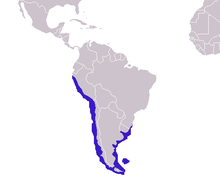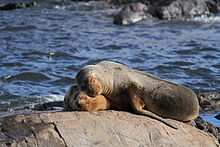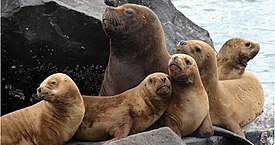South American sea lion
| South American sea lion | |
|---|---|

| |
| Male and female | |
| Scientific classification | |
| Domain: | Eukaryota |
| Kingdom: | Animalia |
| Phylum: | Chordata |
| Class: | Mammalia |
| Order: | Carnivora |
| Clade: | Pinnipedia |
| Family: | Otariidae |
| Genus: | Otaria Péron, 1816 |
| Species: | O. flavescens
|
| Binomial name | |
| Otaria flavescens (Shaw, 1800)[2]
| |

| |
| South American sea lion range | |
| Synonyms | |
|
Otaria bryonia | |
The South American sea lion (Otaria flavescens, formerly Otaria byronia), also called the southern sea lion and the Patagonian sea lion, is a
Naming
The South American sea lion was classified as Otaria flavescens by George Shaw in 1800 and as Otaria byronia by Henri Marie Ducrotay de Blainville in 1820. The two nomenclatures were historically used interchangeably, but O. flavescens has become the preferred name.[3][4] The species is also known by the common name "southern sea lion", although it is not preferred since the Australian sea lion and New Zealand sea lion also range in the Southern Hemisphere. Locally, it is known by several names, including león marino (sea lion) and lobo marino (sea wolf).[3]
Description


The South American sea lion is among the largest of and most sexually dimorphic of the eared seals. Males measure up to 3 m (9.8 ft) in length with a weight of 350 kg (770 lb) while females reach a length 2 m (6 ft 7 in) and reach 150 kg (330 lb) in weight. Pups are born 0.86 m (2 ft 10 in) long and weigh 12–15 kg (26–33 lb). Size differences between the sexes exists in both newborns and juveniles.[3]
Adult males have large heads with short, upturned snouts and long manes which reach the shoulders.
Ecology
The South American sea lion is found along the coasts and offshore islands of South America, from Peru south to

South American sea lions breed on beaches made of sand, gravel, rocky, or pebble. They can also be seen on flat, rocky cliffs with tidepools. Sea lion colonies tend to be small and scattered, especially on rocky beaches. The colonies make spaces between each individual when the weather is warm and sunny.[5]
South American sea lions consume numerous species of
Life history

Mating occurs between December and February. Males arrive first to establish and defend

During the breeding season, males that fail to secure territories and harems, most often subadults, will cause group raids in an attempt to change the status quo and gain access to the females. Group raids are more common on sandy beaches than rocky ones. These raids cause chaos in the breeding harems, often splitting mothers from their young. The resident males try to fight off the raiders and keep all the females in their territorial boundaries. Raiders are often unsuccessful in securing a female, but some are able to capture some females or even stay in the breeding area with one or more females. Sometimes, an invading male abducts pups, possibly as an attempt to control the females. They also take pups as substitutes for mature females. Subadults herd their captured pups and prevent them from escaping, much like adult males do to females. A pup may be mounted by its abductor, but intromission does not occur. While abducting pups does not give males immediate reproductive benefits, these males may gain experience in controlling females. Pups are sometimes severely injured or killed during abductions.[14][15]
Despite being mostly a harem-territorial species, one population in Peru has been recorded having a lek-like breeding system. Here, with its longer ratio of males in comparison to females, the males cluster together and display and try to attract females while allowing then to move freely. The warmer climate also makes the females move constantly to the water, further making the traditional mating system difficult to maintain. The group raids that exist in temperate populations are virtually non-existent here.[16]

Sea lion mothers remain with their newborn pups for nearly a week before making a routine of taking three-day foraging trips and coming back to nurse the pups.[13][5] They act aggressively to other females that come close to their pups, as well as alien pups that try to get milk from them.[17] Pups first enter the water at about four weeks and are weaned at about 12 months. This is normally when the mother gives birth to a new pup. Pups gradually spend more time in the nearshore surf and develop swimming skills.[5]
South American sea lions are observed to make various vocalizations and calls which differ between sexes and ages. Adult males make high-pitched calls during aggressive interactions, barks and growls when establishing territories, growls when interacting with females, and exhalations after antagonistic encounters. Females with pups make a mother primary call when interacting with their pups, and grunts during aggressive encounters with other females. Pups make pup primary calls. Some of those vocalizations and acoustic features may support individuality.[18]
Human interactions

The
Indigenous peoples of South America exploited this species for millennia and by Europeans around the 16th century.[21] The hunting has since gone down and the species is no longer threatened. The species is protected in most of its range. Numerous reserves and protected areas at rookeries and haul-out sites exist for the sea lions. Despite this, protection regulations are not effectively enforced in much of animals' range.[1]
The overall population of sea lions is considered stable; the estimate is 265,000 animals. They are declining in the Falkland Islands, and in Argentina
See also
- Unihemispheric slow-wave sleep
- Pincoy – a sea-spirit in Chilote mythology that resembles a sea lion
References
- ^ . Retrieved 18 February 2022.
- ^ Shaw, George (1800). "Yellow seal". General Zoology. Vol. 1. Part 2. Mammalia. London: G. Kearsley. pp. 260–261.
- ^ ISBN 978-0123735539.
- doi:10.1111/j.1748-7692.1993.tb00470.x.)
{{cite journal}}: CS1 maint: multiple names: authors list (link - ^ ISBN 0-375-41141-0.
- doi:10.1016/j.dsr2.2012.09.005.)
{{cite journal}}: CS1 maint: multiple names: authors list (link - hdl:11336/100897.)
{{cite journal}}: CS1 maint: multiple names: authors list (link - PMID 28616194.
- S2CID 17252548.)
{{cite journal}}: CS1 maint: multiple names: authors list (link - PMID 26649403.)
{{cite journal}}: CS1 maint: multiple names: authors list (link - doi:10.1139/z93-273.
- S2CID 129921828.)
{{cite journal}}: CS1 maint: multiple names: authors list (link - ^ JSTOR 4534669.)
{{cite journal}}: CS1 maint: multiple names: authors list (link - doi:10.1163/156853988X00034.)
{{cite journal}}: CS1 maint: multiple names: authors list (link - JSTOR 4534718.)
{{cite journal}}: CS1 maint: multiple names: authors list (link - .
- S2CID 19971887.
- JSTOR 4535623.)
{{cite journal}}: CS1 maint: multiple names: authors list (link - Thames and Hudson, 1997.
- ^ "Los Lobos Marinos « Historia de Mar del Plata". 9 May 2011. Archived from the original on 9 May 2011. Retrieved 13 August 2022.
- doi:10.1002/(SICI)1099-0755(1998110)8:6<721::AID-AQC309>3.0.CO;2-L.)
{{cite journal}}: CS1 maint: multiple names: authors list (link - PMID 26649403.)
{{cite journal}}: CS1 maint: multiple names: authors list (link





